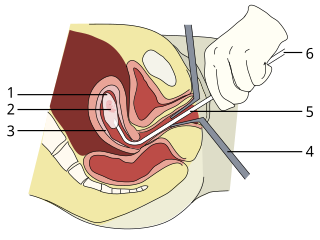Abortion is the termination of a pregnancy by removal or expulsion of an embryo or fetus. An abortion that occurs without intervention is known as a miscarriage or "spontaneous abortion"; these occur in approximately 30% to 40% of all pregnancies. When deliberate steps are taken to end a pregnancy, it is called an induced abortion, or less frequently "induced miscarriage". The unmodified word abortion generally refers to an induced abortion. The most common reasons women give for having an abortion are for birth-timing and limiting family size. Other reasons reported include maternal health, an inability to afford a child, domestic violence, lack of support, feeling they are too young, wishing to complete education or advance a career, and not being able or willing to raise a child conceived as a result of rape or incest.
Intact dilation and extraction is a surgical procedure that terminates and removes an intact fetus from the uterus. The procedure is used both after miscarriages and for abortions in the second and third trimesters of pregnancy. When used to perform an abortion, an intact D&E can occur after feticide or on a live fetus.

Abortion in the United Kingdom is de facto available under the terms of the Abortion Act 1967 in Great Britain and the Abortion (No.2) Regulations 2020 in Northern Ireland. The procurement of an abortion remains a criminal offence in Great Britain under the Offences Against the Person Act 1861, although the Abortion Act provides a legal defence for both the pregnant woman and her doctor in certain cases. Although a number of abortions did take place before the 1967 Act, there have been around 10 million abortions in the United Kingdom. Around 200,000 abortions are carried out in England and Wales each year and just under 14,000 in Scotland; the most common reason cited under the ICD-10 classification system for around 98% of all abortions is "risk to woman's mental health."

In the United States, abortion is a divisive issue in politics and culture wars, though a majority of Americans support access to abortion. Abortion laws vary widely from state to state.

The Partial-Birth Abortion Ban Act of 2003 is a United States law prohibiting a form of late termination of pregnancy called "partial-birth abortion", referred to in medical literature as intact dilation and extraction. Under this law, any physician "who, in or affecting interstate or foreign commerce, knowingly performs a partial-birth abortion and thereby kills a human fetus shall be fined under this title or imprisoned not more than 2 years, or both". The law was enacted in 2003, and in 2007 its constitutionality was upheld by the U.S. Supreme Court in the case of Gonzales v. Carhart.
Late termination of pregnancy, also referred to politically as third trimester abortion, describes the termination of pregnancy by inducing labor during a late stage of gestation. In this context, late is not precisely defined, and different medical publications use varying gestational age thresholds. As of 2015, in the United States, more than 90% of abortions occur before the 13th week, 1.3% take place after the 21st week, and less than 1% occur after 24 weeks.

The Unborn Victims of Violence Act of 2004 is a United States law that recognizes an embryo or fetus in utero as a legal victim, if they are injured or killed during the commission of any of over 60 listed federal crimes of violence. The law defines "child in utero" as "a member of the species Homo sapiens, at any stage of development, who is carried in the womb."

Pregnancy is the time during which one or more offspring develops (gestates) inside a woman's uterus (womb). A multiple pregnancy involves more than one offspring, such as with twins.
Fetal rights are the moral rights or legal rights of the human fetus under natural and civil law. The term fetal rights came into wide usage after Roe v. Wade, the 1973 landmark case that legalized abortion in the United States and was essentially overturned in 2022. The concept of fetal rights has evolved to include the issues of maternal substance use disorders, including alcohol use disorder and opioid use disorder. Most international human rights charters "clearly reject claims that human rights should attach from conception or any time before birth." While most international human rights instruments lack a universal inclusion of the fetus as a person for the purposes of human rights, the fetus is granted various rights in the constitutions and civil codes of some countries.
In pregnancy terms, quickening is the moment in pregnancy when the pregnant woman starts to feel the fetus's movement in the uterus. It was believed that the quickening marked the moment that a soul entered the fetus, termed ensoulment.
The born alive rule is a common law legal principle that holds that various criminal laws, such as homicide and assault, apply only to a child that is "born alive". U.S. courts have overturned this rule, citing recent advances in science and medicine, and in several states feticide statutes have been explicitly framed or amended to include fetuses in utero. Abortion in Canada is still governed by the born alive rule, as courts continue to hold to its foundational principles. In 1996, the Law Lords confirmed that the rule applied in English law but that alternative charges existed in lieu, such as a charge of unlawful or negligent manslaughter instead of murder.
In Judaism, views on abortion draw primarily upon the legal and ethical teachings of the Hebrew Bible, the Talmud, the case-by-case decisions of responsa, and other rabbinic literature. While most major Jewish religious movements discourage abortion, except to save the life of a pregnant woman, authorities differ on when and whether it is permitted in other cases.

The beginning of human personhood is the moment when a human is first recognized as a person. There are differences of opinion about the precise time when human personhood begins and the nature of that status. The issue arises in a number of fields, including science, religion, philosophy, and law, and is most acute in debates about abortion, stem cell research, reproductive rights, and fetal rights.

Born alive laws in the United States are fetal rights laws that extend various criminal laws, such as homicide and assault, to cover unlawful death or other harm done to a fetus in utero or to an infant that has been delivered. The basis for such laws stems from advances in medical science and social perception, which allow a fetus to be seen and medically treated as an individual in the womb and perceived socially as a person, for some or all of the pregnancy.
Definitions of abortion vary from one source to another. Abortion has many definitions that can differ from each other in significant ways. Given the contentious nature of abortion, lawmakers and other stakeholders often face controversy in defining abortion. Language referring to abortion often reflects societal and political opinions . Influential non-state actors like the United Nations and the Roman Catholic Church have also engendered controversy over efforts to define abortion.
Abortion in Samoa is only legal if the abortion will save the mother's life or preserve her physical or mental health and only when the gestation period is less than 20 weeks. In Samoa, if an abortion is performed on a woman for any other reason, or if a woman performs a self-induced abortion, the violator is subject to seven years in prison.
Purvi Patel is an Indian American whose conviction and sentence to 20 years in prison in Indiana for feticide and child neglect was overturned by the Indiana Court of Appeals. The court pointed out that the lower court's ruling had been an "abrupt departure" from the intent of the feticide law as shown by prior usage, which consisted of cases in which a pregnant woman and her unborn child were the victims of violence. The court also said that it was not possible to claim that lawmakers had intended the feticide law to be used to prosecute women trying to abort because the state abortion laws had already since the 1800s explicitly protected pregnant women from prosecution. "The state's about-face in this proceeding is unsettling, as well as untenable" under prior court precedent, Judge Terry Crone wrote in the ruling. The court said that Patel endangered the child by not seeking medical care but that prosecutors failed to prove that her failure to do so resulted in the child's death.
Pregnancy loss is the loss of an embryo or fetus. The terms early pregnancy loss and late pregnancy loss are often used but there is no consensus over their definitions.
Abortion in Ghana is banned except when there is a valid exemption. The abortion should also be conducted only at a government hospital; registered private hospital, clinics registered under the Private Hospitals and Maternity Homes Act, 1958 and a place approved by the Minister of Health by a Legislative Instrument. Illegal abortions are criminal offenses subject to at most five years in prison for the pregnant woman who induced said abortion, as well as for any doctor or other person who assisted this pregnant woman in accessing, or carrying out, an abortion. Attempts to cause abortions are also criminal, as are the purveyance, supply, or procurement of chemicals and instruments whose intent is to induce abortions.

In accordance with Egyptian law, abortion is considered a criminal act that violates the right to life, as it is often intended to terminate the fetus right to future life. The Egyptian legislature has dedicated a separate chapter in the Penal Code, Title III, titled "Abortion of Pregnant Women and the Manufacture and Sale of Adulterated Drinks Harmful to Health." Egyptian law does not explicitly define abortion. Instead, it outlines the various forms of abortion and the corresponding penalties. The Egyptian Court of Cassation defines it as "deliberately terminating a pregnancy prematurely."








